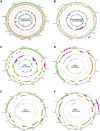Genome Organization and Adaptive Potential of Archetypal Organophosphate Degrading Sphingobium fuliginis ATCC 27551
- PMID: 31504476
- PMCID: PMC6934885
- DOI: 10.1093/gbe/evz189
Genome Organization and Adaptive Potential of Archetypal Organophosphate Degrading Sphingobium fuliginis ATCC 27551
Abstract
Sphingobium fuliginis ATCC 27551, previously classified as Flavobacterium sp. ATCC 27551, degrades neurotoxic organophosphate insecticides and nerve agents through the activity of a membrane-associated organophosphate hydrolase. This study was designed to determine the complete genome sequence of S. fuliginis ATCC 27551 to unravel its degradative potential and adaptability to harsh environments. The 5,414,624 bp genome with a GC content of 64.4% is distributed between two chromosomes and four plasmids and encodes 5,557 proteins. Of the four plasmids, designated as pSF1, pSF2, pSF3, and pSF4, only two (pSF1 and pSF2) are self-transmissible and contained the complete genetic repertoire for a T4SS. The other two plasmids (pSF3 and pSF4) are mobilizable and both showed the presence of an oriT and relaxase-encoding sequences. The sequence of plasmid pSF3 coincided with the previously determined sequence of pPDL2 and included an opd gene encoding organophosphate hydrolase as a part of the mobile element. About 15,455 orthologous clusters were identified from among the cumulatively annotated genes of 49 Sphingobium species. Phylogenetic analysis done using the core genome consisting of 802 orthologous clusters revealed a close relationship between S. fuliginis ATCC 27551 and bacteria capable of degradation of polyaromatic hydrocarbon compounds. Genes coding for transposases, efflux pumps conferring resistance to heavy metals, and TonR-type outer membrane receptors are selectively enriched in the genome of S. fuliginis ATCC 27551 and appear to contribute to the adaptive potential of the organism to challenging and harsh environments.
Keywords: biodegradation; genome sequence; horizontal gene transfer; mobile elements; organophosphate hydrolase; plasmids.
© The Author(s) 2019. Published by Oxford University Press on behalf of the Society for Molecular Biology and Evolution.
Figures


Similar articles
-
Multiple mechanisms contribute to lateral transfer of an organophosphate degradation (opd) island in Sphingobium fuliginis ATCC 27551.G3 (Bethesda). 2012 Dec;2(12):1541-54. doi: 10.1534/g3.112.004051. Epub 2012 Dec 1. G3 (Bethesda). 2012. PMID: 23275877 Free PMC article.
-
Reclassification of a parathione-degrading Flavobacterium sp. ATCC 27551 as Sphingobium fuliginis.J Gen Appl Microbiol. 2010 Jun;56(3):249-55. doi: 10.2323/jgam.56.249. J Gen Appl Microbiol. 2010. PMID: 20647682
-
Expression of recombinant organophosphorus hydrolase in the original producer of the enzyme, Sphingobium fuliginis ATCC 27551.Biosci Biotechnol Biochem. 2016 May;80(5):1024-6. doi: 10.1080/09168451.2015.1123606. Epub 2016 Jan 19. Biosci Biotechnol Biochem. 2016. PMID: 26784883
-
Degradative plasmids from sphingomonads.FEMS Microbiol Lett. 2014 Jan;350(1):9-19. doi: 10.1111/1574-6968.12283. Epub 2013 Oct 10. FEMS Microbiol Lett. 2014. PMID: 24111699 Review.
-
Lessons from the genomes of lindane-degrading sphingomonads.Environ Microbiol Rep. 2019 Oct;11(5):630-644. doi: 10.1111/1758-2229.12762. Epub 2019 May 21. Environ Microbiol Rep. 2019. PMID: 31063253 Review.
Cited by
-
Unveiling degradation mechanism of PAHs by a Sphingobium strain from a microbial consortium.mLife. 2022 Jul 25;1(3):287-302. doi: 10.1002/mlf2.12032. eCollection 2022 Sep. mLife. 2022. PMID: 38818225 Free PMC article.
-
Recent Advanced Technologies for the Characterization of Xenobiotic-Degrading Microorganisms and Microbial Communities.Front Bioeng Biotechnol. 2021 Feb 10;9:632059. doi: 10.3389/fbioe.2021.632059. eCollection 2021. Front Bioeng Biotechnol. 2021. PMID: 33644024 Free PMC article.
-
TonB-Dependent Transporters in Sphingomonads: Unraveling Their Distribution and Function in Environmental Adaptation.Microorganisms. 2020 Mar 3;8(3):359. doi: 10.3390/microorganisms8030359. Microorganisms. 2020. PMID: 32138166 Free PMC article. Review.
-
Unlocking the potential of soil microbial communities for bioremediation of emerging organic contaminants: omics-based approaches.Microb Cell Fact. 2024 Jul 25;23(1):210. doi: 10.1186/s12934-024-02485-z. Microb Cell Fact. 2024. PMID: 39054471 Free PMC article. Review.
-
Dissemination of metaldehyde catabolic pathways is driven by mobile genetic elements in Proteobacteria.Microb Genom. 2022 Oct;8(10):mgen000881. doi: 10.1099/mgen.0.000881. Microb Genom. 2022. PMID: 36301081 Free PMC article.
References
Publication types
MeSH terms
LinkOut - more resources
Full Text Sources
Molecular Biology Databases
Research Materials
Miscellaneous

